Deflex Strategy Guide
How to Play Deflex
Objective
Deflex is, I s'pose, halfway between being a puzzle game and an action game. It's partially puzzle because on some levels it's necessary to work out what the best strategy to complete a level is; and it's partly action, because it demands a degree of dexterity and timing to complete a level.
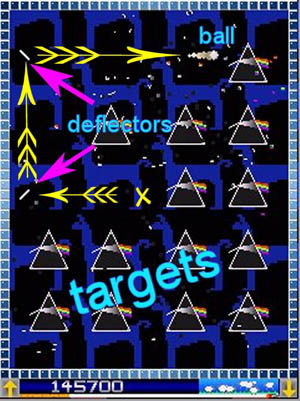
The basic elements of a Deflex level. The player introduces Deflectors to move the Ball so that it collides with all the Targets.
The objective on any given level is to deflect a ball so that it hits all the targets on that level, before a time limit expires. The controls are simple, and consist of two buttons, used to place one of two different types of deflector in front of the ball.
How Deflectors Work
There are two Deflectors that can be placed in front of the ball in Deflex. The Left Deflector is angled like a slash '/' and is placed by the Left Deflector Button; the Right Deflector is angled like a backslash '\' and is placed, you will be amazed to learn, by the Right Deflector Button.
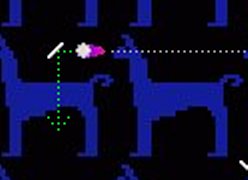
Deflector as mirror: how the trajectory of the ball will be affected by a Left Deflector.
The ball is always moving in a horizontal or vertical direction; think of the two Deflector types as angled mirrors in the ball's path. They cause the ball to bounce off them and in doing so turn its path through 90 degrees, as illustrated in the example above.
One of the key aspects of Deflex, and something which makes the ball's trajectory through a screen full of Deflectors a lot more interesting than it would otherwise be, is that whenever the ball hits a Deflector, that Deflector changes state. There are only two different states a Deflector can be in - Left Deflector or Right Deflector. With each hit of the ball, the Deflector toggles between these two states.
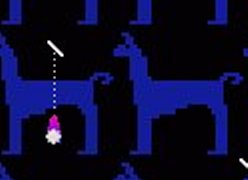
Aftermath of the ball's deflection - the Deflector has flipped over and become a Right Deflector.
To get a better idea of how the Deflectors work, fire up Deflex on your PocketPC and choose 'How To Play' from the main menu screen, and watch the little demonstration there.
Deflex Controls
The controls in Deflex are very simple indeed - just a Left Deflector Button, a Right Deflector Button and a Quit button which you can use to end a Deflex session and Resume it later.

These are the default buttons for the ARM version of Deflex.
If your device is not one of the default ones here, or if you simply don't like my default key allocations, then you can go to the Settings and Information option in the menu and choose Set Preferred Buttons - this will take you to a screen where you can set your own choice of deflector and quit buttons. Your button preferences will be saved along with the hi-score information when you exit the game.
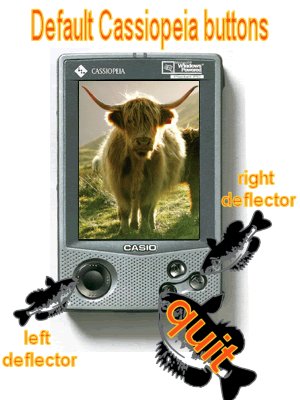
And here are the default buttons for the MIPS version of Deflex.
Game Structure
There are fifty levels in total in Deflex. In order to see all 50 of those levels and complete the game, it is necessary to play the game through in each of three difficulty levels.
Fluffy Difficulty
This is the easiest level of Deflex gameplay. The ball moves at a slower pace, and if you should lose a life on a particular level, then targets you already hit on that level do not reappear when the level restarts. Except on that bastard level with the Space Invaders. A Fluffy Difficulty game ends after 30 levels.
Hairy Difficulty
This is the next most difficult level of Deflex gameplay. The ball moves faster than in Fluffy difficulty, but as in Fluffy difficulty, targets cleared during a level don't reappear if that level has to be restarted, except on that bastard level with the Space Invaders. A Hairy Difficulty game ends after 40 levels.
Beastly Difficulty
This is the most challenging level of Deflex gameplay. The ball speed is fast as in Hairy difficulty level, and if you lose a life on a level, then all the targets are reset and you must do the entire level again. This makes for a fearsomely difficult game of Deflex - but it is only by playing through in Beastly difficulty that you will get to see the last ten levels.
There are four Player Slots. Each Player Slot has a name associated with it, along with that player's hi-score and Resume information. Upon choosing a Player Slot, you have the option to rename the player, clear out the Slot, resume a game in progress, or begin a new game on any of the three difficulty levels.
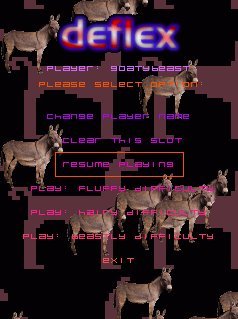
Choosing a player leads to the Player Slot menu.
You can pause a game, of course, just by turning off your PPC. However if you have a game in progress and you want to quit out to, er, maybe do something useful with your PPC instead, you can use the Resume feature.
During a level, if you press the Quit button, then the score you had at the beginning of that level, and the number of lives remaining, is saved to your Player Slot. When you quit the game this info is saved with the hi-score table. Upon reloading, you can choose Resume Game from within your Player Slot, and you'll be placed back in the game at the beginning of the level you quit on, with your score and lives intact.
There is a Player Slot called 'Guest', which can be used if someone wants to play and not alter the Slot settings of already-registered players. This works just like the others except that the contents aren't saved and the player name can't be changed from 'Trevor the Goat'.
Your Player Slot also records your progress through the game so far. You can choose to start a new game beginning at any level that you have already reached before. When starting from fresh, you may choose to begin on any of the first five levels.
Gameplay Features
As outlined above, the basic idea of Deflex gameplay is very simple - each screen has a number of targets which must be hit to clear the level. However there are a variety of hazards which may conspire to make that goal more difficult to achieve.
Your first and most basic enemy is Time itself. Looking at the status area above, you can see that time is represented by the Fag of Time, a long, thin cigarette at the bottom of the screen. Each level's Fag of Time burns at a specific rate, and the player must hit all the targets before the Fag of Time burns down to the Filter of Despair.
Hitting targets causes more time to be added to the Fag of Time, effectively partially unsmoking it. A special bonus is awarded for keeping the Fag of Time as unsmoked as possible!
Running out of time causes you to lose a life. Lives are represented by tiny Lambs of Life, which bounce around happily in the Pasture of Contentment at the right-hand side of the status display. Completing a level gets you a new Lamb of Life - but running out of time, or otherwise failing on a level, causes one Lamb of Life to be lost.
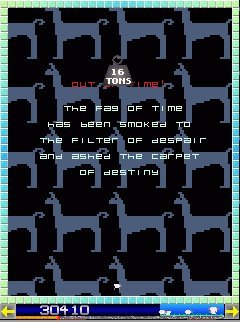
Run out of time, and a Lamb of Life will meet a Monty-Pythonesque end.
The rest of the status area is fairly self-explanatory - your score is shown, and the two arrow indicators at either end show which direction the ball would go if you were to place the corresponding Deflector in front of the ball at that moment. You may find it useful to look at the indicators while you are learning to play Deflex, but after a while it becomes second nature to know which Deflector will move the ball in a particular direction.

On the easiest difficulty level, the left and right deflection direction indicators appear next to the ball itself, in a kind of 'head-up display'.
There are other factors which can cause you to fail a level and lose a Lamb of Life. Some levels are Sequential Levels, in which the targets must be hit in a particular order. The next target in the sequence is indicated by a large floating purple arrow, and if you hit a target out of sequence, you invoke a Clumsy Donkey Error, lose a life and have to try again.
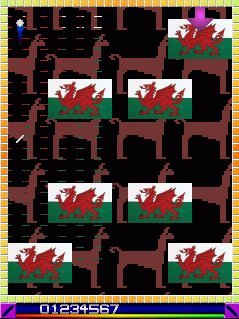
The Welsh flags must be hit in the right order, or you'll lose a life!
Some levels have targets which move about, making it harder to collect them all in the time allocated. Some levels have targets which actively run away from your ball. Levels which have targets which move and which also must be collected sequentially are particularly difficult!
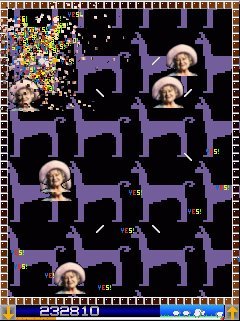
The last few Queen Mothers move particularly quickly and can be tricky to get within the time allowed.
There are levels which have walls that the ball must not touch, and levels where the enemies fire projectiles that your ball must avoid; levels that have enemies that can only be destroyed from above (the Falling Weights and Falling Yaks)...
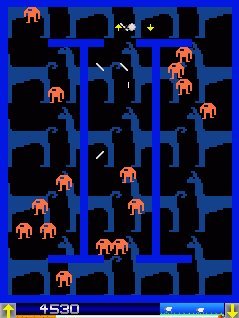
There is double jeopardy on this level. The robots fire lethal projectiles, and the walls are deadly!
There are even levels where your ball is threatened by enormous fluffy sheepie plushies.
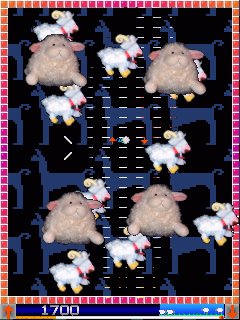
The big gormless-looking fluffy sheepie plushies move slowly but inexorably. Great dexterity is needed to manoeuvre around them.
Scoring and Strategy
Strategy? Strategy? It's hardly a game of bleedin' chess, is it?
Like any decent game, though, it's not just a matter of completing the levels; getting through the game is one thing, but getting through it in such a way as to maximise your score is the main challenge. This is what gives a game replayability - if there is always a slightly higher score to strive for, a few more points to be gained...
The player can maximise his score for a level by completing it efficiently, using as little time as possible, and using as few deflectors as possible. In-game scoring depends upon bith time elapsed and the number of deflectors placed since the last target was hit. Particular efficiency and certain flourishes are rewarded with bonuses at the end of each level.
At the end of the game - after 30 levels in Fluffy difficulty, 40 in Hairy difficulty and 50 in Beastly difficulty - the player is rewarded for any lives remaining, and the final score is calculated.
And that's it, really - now you know how to play Deflex. Let me know what kind of hi-scores you achieve, and if there is enough interest I will start a Hi-Scores page on the website.
More >>>













